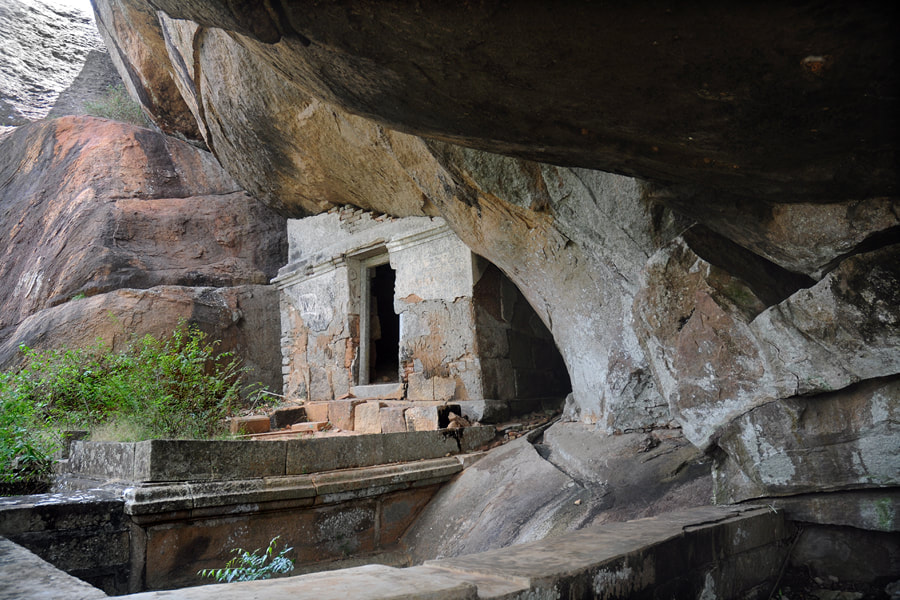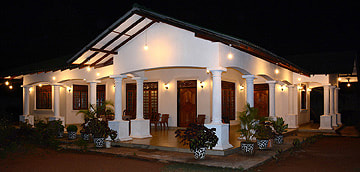Sri Lanka's ancient Sinhalese civilization, which lasted from the 5th century B.C.E. till the 13th century C.E., cultivated the dry zone of the island by developing an admirably elaborate irrigation system on a huge scale. Those days, Sri Lanka's otherwise feral dry zone was much more densely populated than today and than in contemporary medieval Europe. This is the reason why today's Cultural Triangle to the north of the central highlands as well as the plains in the east and south are crowded with ruins of ancient temples.
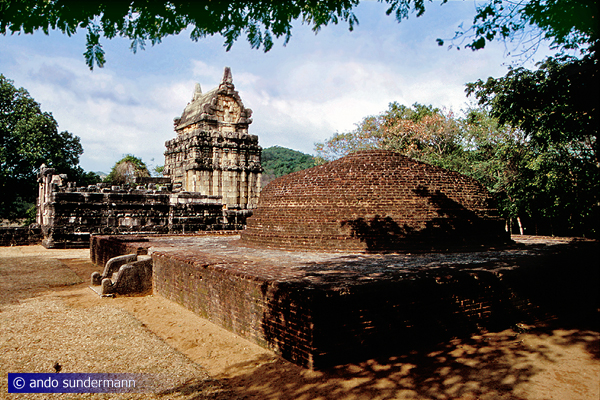
Only sacred buildings were made of stone and brick, even royal places were wooden or of other perishable materials and thus disappeared in the course of the centuries. Hence almost all remnants of buildings of the ancient Sinhalese civilization are monastic architecture, mainly Buddhist, a few were Hindu. Besides stupa buildings, which are the characteristic element of Sinhalese temples, there were walkable shrine rooms, too. Most of them are called image houses (Pathimagharas), because a Buddha statue was the main object of worship in their interior rooms. Only a few are still intact, like the completely restored Nalanda Gedige. More often, only foundation walls made of brick and stone pillars or door frames survived till the present day. Most cultural tourists only visiting World Heritage Sites get no sufficient impression of the huge amount of archaeological sites in Sri Lanka. Apart from the Mediterranean, the Middle East and Mexico, Sri Lanka is probably one of the countries most densely covered with excavation sites from the historical precolonial period, this means from the period that had already developped the art of writing and was not yet a victim of Western invasions. Many of Sri Lanka's ancient temples are hidden and off the beaten track. The good news is: You can still explore them undisturbed by mass tourism.
Mihintale
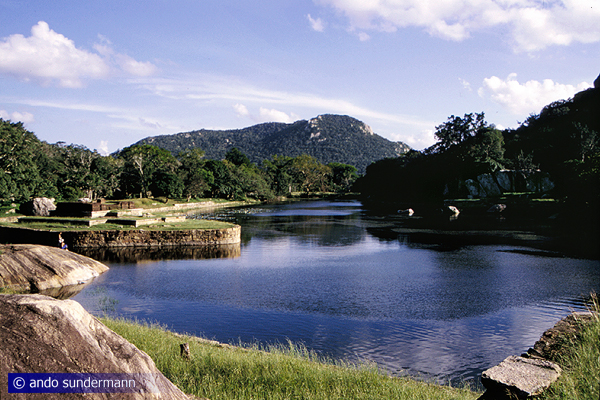
Mihintale is known as the birthplace of Sinhalese Buddhism. Many tourists visit the Ambasthala Dagaba marking the spot, where Monk Mahinda met Sri Lanka's king for the first time. Climbing the long stairways to the Ambasthale terrace, you will see ruins of an ancient monastery, stupas, refectory, image houses etc. Mihintale was a large monastery throughout the Anuradhapura period. Like Anuradhapura, it has fallen into decay since the 11th century. But for the first 1300 years the monastic complex in and around the sacred hills of Mihintale, known as Chetiyapabbata in ancient chronicles, had been enlarged and embellished and restored regularly. There are many lovely sites bearing witness to Mihintale's ancient splendour. Some of them are rarely visited. One of the most beautiful parts of Mihintale's excavation area is Kaludiya Pokuna, an artificial lake sheltering a former assembly hall. More...
Abhayagiri in Anuradhapura
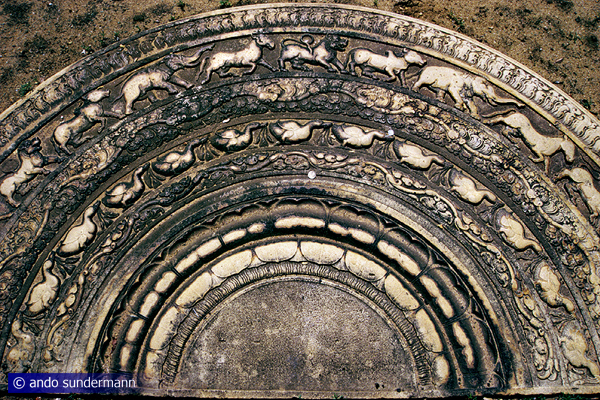
The largest monastery of the ancient Sinhalese civilisation - and today's largest excavation site on the island - is not surprisingly to be found in the first capital of Sri Lanka, Anuradhapura. The white dome of the Ruwaanweliseya dagaba, the Brazen Palace and the Sacred Bo-tree in Anuradhapura all belong to the island's first Buddhist monastery, Mahavihara. However, two centuries later, a scond vast moanstic complex was established further north in Anuradhapura. In the course of the centuries, it became even larger than Mahavihara and more monks lived in this second main temple, which is called Abhayagiri. Abhayagiri was most important in the development of Sri Lanka's sculptural art. The best examples of a Buddha statue, a Nagaraja guardstone and a moonstone can be found in the Abhayagiri complex. Other monasteries, like Mahavihara, were soon inspired by these examples set by the Abhayagiri. More...
Haththikuchchi
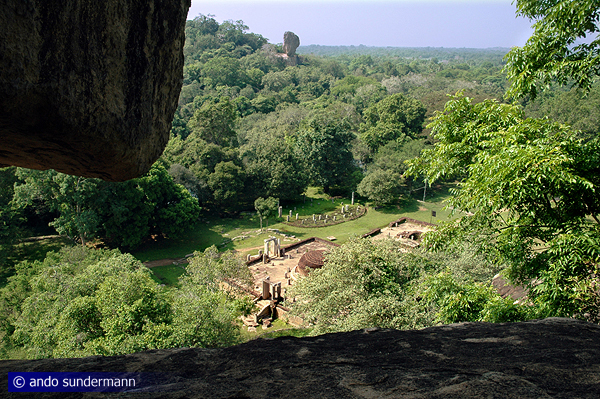
The ruins of Rayangane have become a pilgrimage site for Sinhalese Buddhists again, since historians regard it to be the place called Haththikuchchi. This was a pilgrimage site already in antiquitty, because it was believed to be the place, wher the self-sacrifice of King Sirisanghabo took place. King Sirisanghabo is very popular in Sri Lanka, though his death by beheading himself may sound shocking. But this legend does not emphasize cruelty. It gives an example of utmost care for the benefits of a fellow human being. Sirisanghabo gave his had to a poor man to allow him to receive a bounty offered by the new king, who had overthrown Sirisanghabo and feared his return. The ruins near the cave, where Sirisanghabo had lived and sacrificed himself, are a mix of styles of ancient forest monasteries. The temple is situated in a wonderful setting: It's a perfect destination for travellers looking for a faraway ancient site. More...
Nillakgama
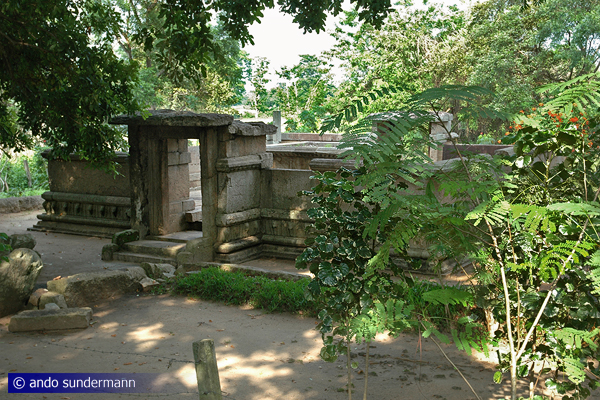
Nillakgama is a very remote ancient temple. In contrast to most other ancient sites, there is only one structure excavated in Nillakgama. But this one temple is something special indeed. It is the best example of a so-called Bodhighara. The term literally means "Bo-Tree-House". Though the tree in Nillakgama does not exist any more, the "house" is remarkably well preserved. A Bodhighara was a very early typical form of Buddhist temples in which - instead of images of Hindu gods - a tree was venerated, symbolizing enlightenment, "Bodhi". Actually,in this way an older form of tree-worship was integrated in Buddhism. The oldest known Buddhist temple - in Lumbini, Nepal, birthplace of the historical Buddha - was a Bodhighara. Depictions of trees growing from within a temple can be seen on stone carvings of India's ancient stupas. But a complete building of this form only survived in Nillakgama.
Menikdena
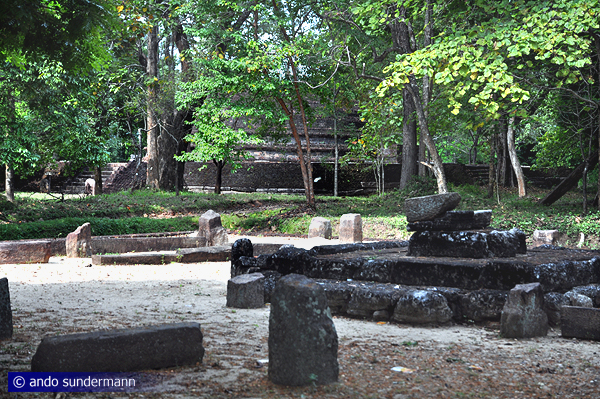
Menikdena became an Archaeological Reserve in 1957. Integrated into the excavation site is an arboretum covering about 14 hectares. Menikdna is really off the beaten track, though situated not far from Dambulla. Though mentioned alreasy in the 3rd or fth century, the final ensemble of Menikdena is a systematically planned monastic complex typical for the late Anuradhapura period. Four major buildings arranged in a square order are surrounded by a rectangular wall. The core stone buildings of such a Sinhalese ancient temple are, besides the chapter hall for assemblies and higher ceremonies of the Buddhist monks, three buildings dedicated to a sacred tree, to a Buddha statue and to relics. These three structures important for religious exercises of laymen even more than for the monastic order are called Bodhighara, Pathimaghara and Dagaba (Stupa) respectively.
Nalanda Gedige
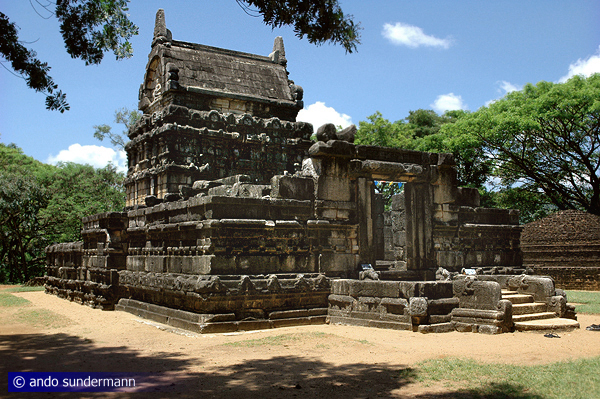
Nalanda Gedige from about the 9th century is an extraordinary temple in many respects. Small in size in comparison to contemporary Indian temples, it is nevertheless Sri Lanka's largest ancient temple built entirely from stone. Bigger buildings in Sinhalese architecture were brick structures, particularly stupas without walkable shrine rooms. The architecture of the temple is influenced by the Southindian Pallava style. It was an unorthodox place of worship in the Buddhist kingdom, either a Hindu or a Tantric shrine. Nalanda Gedige is Sri lanka's only ancient temple decorated with erotic motifs. The temple is an good condition, itt has recently been completely restored with original stones at a higher elevation, because the original site was flooded by a new reservoir for irrigation purposes. The shifting of the ancient temple is the reason why Nalanda Gedige is called "Sri Lanka's Abu Simbel".
Kaludiya Pokuna
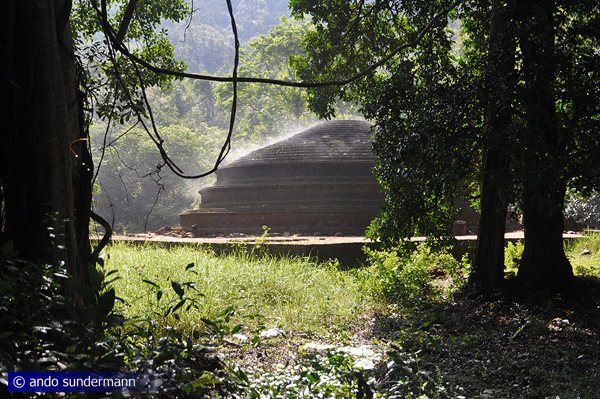
Kaludiya Pokuna at Kandalama near Dambulla and Sigiriya is an ancient temple complex not to be confused with the small tank of the same name in Mihintale (see above). Similar to this namesake, the ancient Vihara is named after blackish water, but it is found in the vicinity, not in the centre of the complex as in Mihintale. The original name was Dakkhinagiri Vihara, meaning "southern hills monastery". For today's visitors, the tranquil archaeological site of Kaludiya Pokuna offers a perfect "lost temple in the jungle" experience. What can be seen in kaludiya Pokuna, is a typical monastery from the late Anuradhapura period. The stupa is well preserved, and impressive stone columns of the chapter house are still standing upright. The earliest of three significant stone inscriptions is from the 7th century, though a first temple is believed to have been built already in the 2nd century B.C.E. by King Saddha Tissa.
Quadrangle in Polonnaruwa
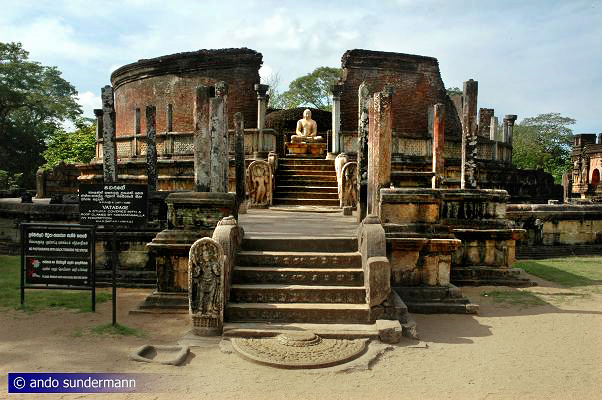
The World heritage sites Anuradhapura and Polonnaruwa are defintiely Sri Lanka's largest excavation sites, overgrown huge ancient temple town. The place most densely covered with magnificent temples is the so-called Quadrangle in the very centre of Polonnaruwa. The former capital's landmark temple, the "circular temple" Vatadage, is one of the edifices on this elevated terrace. Polonnaruwa's very first Tooth Temple was built here by the first Sinhalese Polonnaruwa king, Vijayabahu, in the 11th century. Hence the terrace is known as "Dalada Maluwa", which means "Tooth Pltform". The other ancient temples are from the heydays of the Polonnaruwa Kingdom, the reigns of Parakramabahu and Nissanka Malla in the second half of the 12th century. Some of them are of exceptional design, such as the tower pyramid Satmahal Pasada and the bent columns of the Lotus Mandapa. More...
Medirigiriya

Medirigiriya is one of the most charming ancient sites in Sri Lanka. There are image houses with Buddha sculptures in situ. The landmark temple of Medirigiya is the best-preserved circular temple from the Anuradhapura period, much earlier than the more famous Vatadage in Polonnaruwa. A Vatadage is a round form of a Chetiyaghara, the latter being a roofed temple building containing a small stupa, "Chetiya" is another word for "stupa" or "dagoba" in Sri Lanka, whereas the ending "-ghara" simply means "house". Most Chetiyagharas in Sri Lanka are Vatadages. The central stupas are surrounded by rings of pillars, which once carried a wooden roof. After this superstructure of perishable material disappeared, only the pillars can be seen today, Medirigirya being the perfect example. The Vatadage of Medirigiriya is piterusquely situated in a granite boulde.
Ritigala
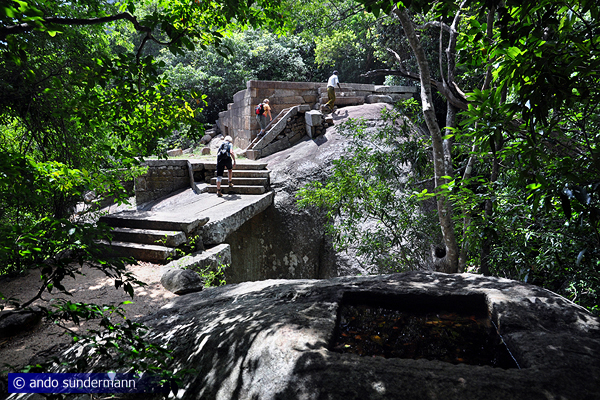
Ritigala is the highhest mountain of the northern half of Sri Lanka, well known for its abundance in herbal plants. It's western slope is a vast excavation site of a monastic complex of a very special kind. Ritigala is the largest temple of a Buddhist reform movement in the 7th till 10th century, which preferred an austere life. This group called Pamsukulikas created several temples throughout the Anuradhapura kingdom . Typical features of their monasteries are elaborate paved "meditation pathes" in the wilderness, hospitals for Ayurvedic herbal treatments, huge bathes, and double platforms called Padhanagharas for meditation. There are no images of Buddhas in Pamsukulika temples. All the more suprising is, that one specific part is carefully decorated with ornamental stone carvings: the toilets and urinal stones. Most likely, this is a symbol of the reclusive monks' contempt of works of art.
Divulwewa
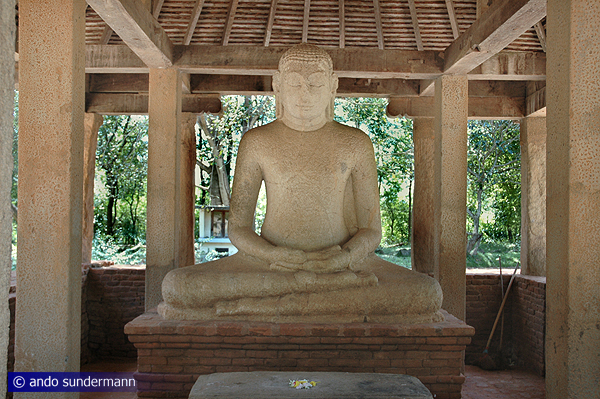
The archaeological site of Divulwewa near Horowupotana surprises its rare visitors with a twin brother of Anuradhapura's world famous Samadhi-Buddha. Due to the evident similarities in style, the Samadhi statue in Divulwewa is believed to have been carved during the same period as the Anuradhapura Samadhi statue. The Divulwewa statue is one of the few Buddha sculptures of this size that have remained in situ. It belongs to an ancient temple complex od which several brickstone foundation walls can still be seen. It's a large compound which presumably has housed hundreds of monks during the Anuradhapura period. Ruins of restored image houses can be identified, one unusual structure is believed to have been a library on stone pillars. Outside the walled monastery grounds is a burial site where ashes of dead monks have been interred and covered with a stone slab.
Kiralagala

Kiralagala near Horowupotana is rarely visited by foreign travellers, though this ancient temple complex had been of some significance for the development of a kind of monastic architecture which is specific to Sri Lanka's forest monasteries and has the largest rectangular bath. The ancient name of the Kiralagala temple is Veherabandigala, also spelt Weherabendigala. It is the earliest example of a large monastic complex of the reform movement called Pamsukulikas. The characteristic feature of temples of this brotherhood are double-plattforms linked by a small bridge, they are called Padhanagharas. Typical elements of these ancient forest monasteries are also Janzhagharas, a kind of Ayurvedic hospitals with warm water facilities.
Kiralagala alias Veherabandigala seems to have been an earlier monastery of the normal kind, with stupas and image houses before being transferred to a forest temple for reclusive monks.
Kiralagala alias Veherabandigala seems to have been an earlier monastery of the normal kind, with stupas and image houses before being transferred to a forest temple for reclusive monks.
Velgam Vehera
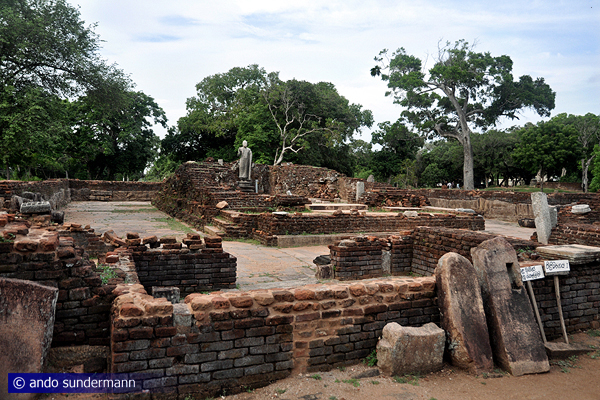
Velgam Vehera is a rarely visited excavation site of a Buddhist monastery close to Trincomalee. Interestingly, the buildings that can be seen at Velgam Vehera have a Tamil background. Though an ancient temple existed here already in the Anuradhapura period, it was during the Chola occupation that this Buddhist monastery was enlarged and embellished and received its central edifice, a large image house. Image houses on such a huge scale were not known previously. In a sense the Southindian Hindu temples of the Cholas inspired Buddhist architecture. Large image houses (Patthimagharas) became a characteristic feature of Buddhist monastic architecture in the subsequent Polonnaruwa period. The fact of restoration by the Cholas and setting an example is all the more remarkable as these Hindu invaders of Sri Lanka are otherwise blamed to have destructed Buddhist temples.
Thiriyai
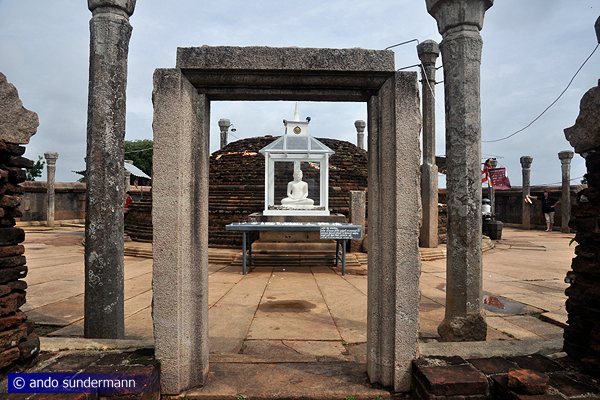
Thiriyai is a village 45 km north of Trincomalee. It is home to the Girihanduseya Vihara, the most significant piece of Buddhist architecture in the Eastern Province. Girihanduseya is the name of the main stupa atop a hill. It is surrounded by a round temple, a Vatadage, a characteristic form of Sinhalese monastic architecture. Indeed, the Vatadage is Sri Lanka's round temple with the best preserved circular wall. The Vatadage is the highlight of a large excavation are, where for example double platforms can be seen, too. The Girihanduseya stupa at likes to be regarded as the oldest Buddhist dagaba in Sri Lanka enshrined with an original hair relic of the Buddha. Devotees believe, that the very first two Buddhist lay people, Thapassu and Balluka, who had met the Buddha 50 days after his enlightenment, received that hair in return for their veneration and finally placed it here on the hill of Thiriyai.
Seruwawila
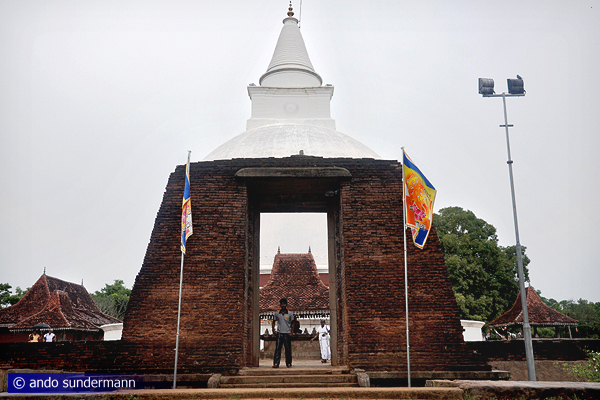
The Seruwawila Mangala Raja Maha Viharaya, also abbreviated "Seruvila", is an ancient Buddhist temple in the southern part of Trincomalee District, it likes to be counted as one of the Solosmasthanas, which are the 16 sites in Sri Lanka visited by Lord Buddha. He is believed to have paid respect to relics of the previous three Buddhas of our era, Kakusandha, Konagammas and Kassapa, which are claimed to be enshrined in the central stupa (dagaba) of Seruwawila. After offering eight handfuls of Sapu flowers, he uttered his wish, that a monastery should be built at this place in the future. This is said to have been done by King Kavan Tissa from the southern kingdom Ruhuna in the 2nd centure B.C.E. He said that a sacred relic of Lord Buddha in his possession was destined to be enshrined here. By fullfilling his vow, his army ccould enter and occupy the ancient principality of Seru without any fight.
Pottuvil
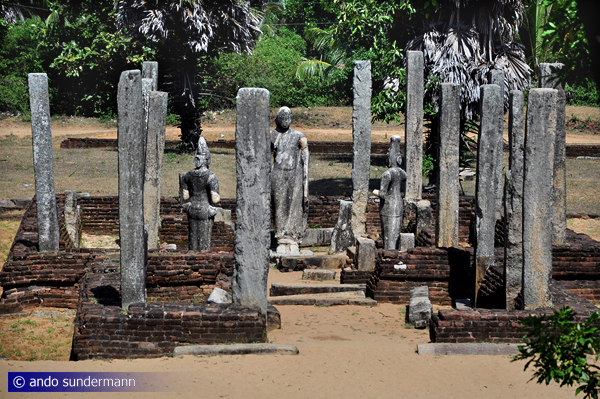
Muhudu Maha Viharaya is a Buddhist temple situated in Pottuvil. Parts of this ancient site are still buried under the sands of Pottuvils large dune field. In popular belief, the temple is attributed to Kavan Tissa, who ruled the southern kingdom Ruhuna in the 2nd century B.C.E. This temple is said to mark the landing place of Viharamahadevi, who was cast to sea in a Golden Vessel to appease the gods, after Kelaniya had been flooded by the ocean as a result of the cruelty of the King of Kelaniya. The stranded princess was married by Ruhuna's King Kavan Tissa and bore him a son, who became the most heroic king in Sinhalese history, Duttha Gamani. The ruins are from the late Anuradhapura period. In the main temple, two smaller sculptures are flanking the Buddha in an unusual arrangement, three statues greeting each other. The two statues, influenced by Mahayana art, depict kings or Bodhisattvas.
Lahugala
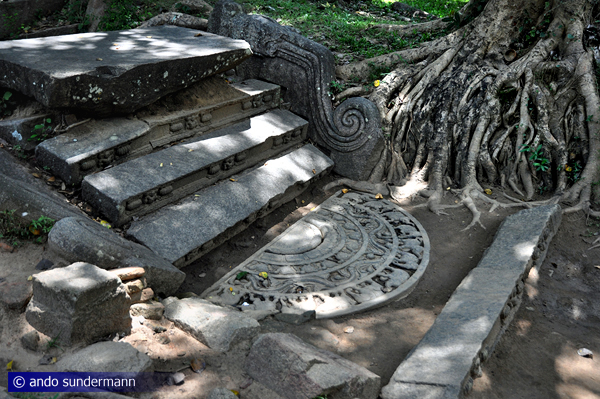
Lahugala is a small national park and also one of the largest excavation sites of an ancient monastic complex in the southeast of Sri Lanka. The temple is called Magul Maha Vihara. It is believed to have been built by King Kavan Tissa in the 2nd Century BC on the location where he married the princess Viharamahadevi, who had run ashore in a golden vessel in the nearby dunes of Pottuvil. The "Wessding Terrace", called "Magul Maduwa” in Pali can be seen in the southwestern corner of the temple premises. It is much more likely, however, that this platform was once the place of the monastery's Sacred Bo-Tree. The entire Vihara complex is surrounded by a rectangular wall. Ruins of image house with moonstone, chapter hall, stupas and ponds are found scattered all over. The moonstone of Lahugala is unique as the only example with carvings depicting mahouts seated on their elephants.
Ramba Vihara
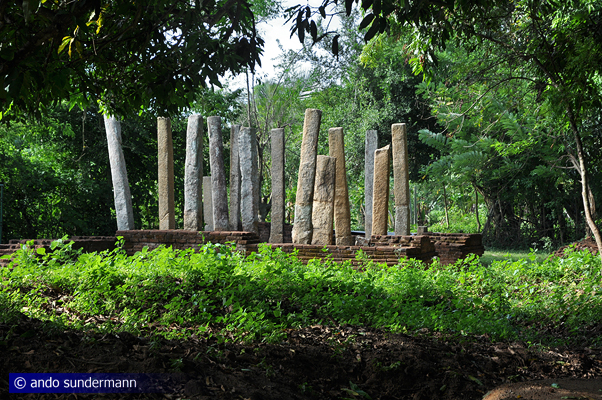
The Ramba Vihara, officially called Ramba Rajamaha Viharaya, is the largest excavation of ancient monastic buildings in the south of Sri Lanka, with lots of foundation walls and several stone carvings in an area of about 50 hectares, partly overgrown. Ramba Vihara is situated on the right bank of the Walawe Ganga near Embilipitiya. What is called Ramba Vihara today, was the Royal Temple of the ancient city Mahanagakula, which was the most significant monastery of the southern kingdom Rohana (Ruhunu) during the Polonnaruwa period. A large number of artifacts have been found here, some of them are on display in the attached small museum now. One notable finding is a strange hollow Buddha image made of white sandstone, unique in Sri Lanka. Mahanagakula was an important town, because it could be reached by ocean vessels and played a role to repulse Chola invaders from South India.
Bandariya Kovil

There are many different spellings for "Barindiya Kovil", for example "Berendi Kovil" or "Barandi Kovila". It is the only stone monument from the Sitavaka period of Sri Lanka's history. Sitavaka, today's Avissawellla, was one of the three major Sinhalese capitals in the 16th century, competing with Kotte, which was mostly under control of the Portuguese, whereas the kings of Sitavaka, Mayadunne and Rajasinha I, continuously faught against the invaders. Mayadunne won the Battle of Mulleriyawa, which was the worst defeat of the Portuguese by an Asian army during that period. This contributed significantly to the independence of the central highlands from Portuguese rule. Remarkably, Barandiya Kovil is, as already indicated by the Tamil name "Kovil" for "Temple", a Hindu sanctuary. It is attributed to King Rajasinha, who was the only Sinhalese ruler who persecuted Buddhism.
Dambadeniya
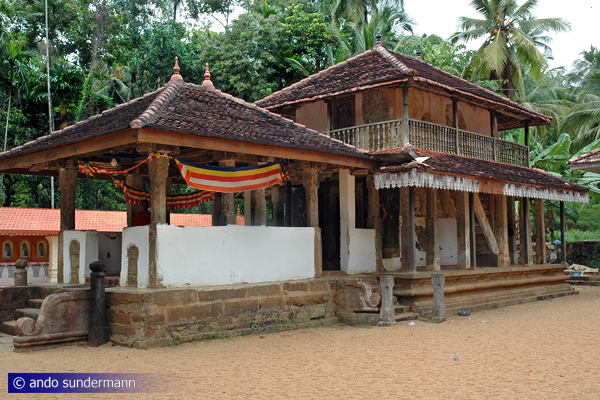
After the fall of Polonnaruwa, Dambadeniya became Sri Lanka's new capital, as the place where the Sacred Tooth Relic was enshrined. Similar to Yapahuwa, which was fortified at the end of the same century, Dambadeniya had a palace on a rock. Only few remnants of it can be seen today, but climbing the Dambadeniya rock is rewarding because of the scenery. In the plains to the west of the rock was the Tooth Temple. In the 18th centuries, it was restored under Kandyan patronage, as a typical wooden temple from that Kandy period. The Vijayasundarama temple is worth visiting for the excellent murals in the Kandyan style, which can be seen in the upper storey. The Dambadeniya period, particularly the long reign of King Parakrambahu II (1236-70), is regarded as the Golden Era of Sinhalese literature. Politcally, it is atransitional period shifting the seat of power to the southwest.
Arankale
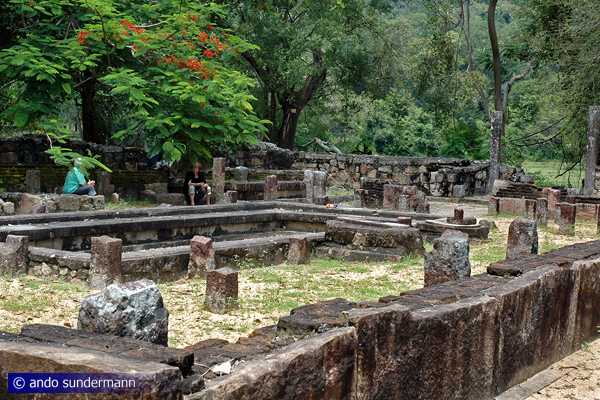
Arankale in Kurunegala District is an excavation site of an ancient forest monastery, quite idyllic and completely off the beaten path. The ruins are nestled in the jungle at the foot of a hill called Dolukanda, which is believed to be a Sanjivani drop, similar to Ritigala. Historically, Arankale was, like Ritigala, a monastery of the fraternity called Pamsukulika. This is why many double-platforms can be found in the area and the most significant structure is an Ayurvedic hospital. In contrast to the meditation path of Ritigala, the monastic path in Arankale is almost flat. The name “Arankale” is either derived from “Aranya”, a common name for forest, or "Arahan”, a term for an enlightened follower of Buddha. “Kale” again means “forest“. Maliyadeva, one of the most famous Arahans in Sri Lanka, is believed to have lived here in the early Anuradhapura period in a cave now bearing his name.
Panduvasnuwara
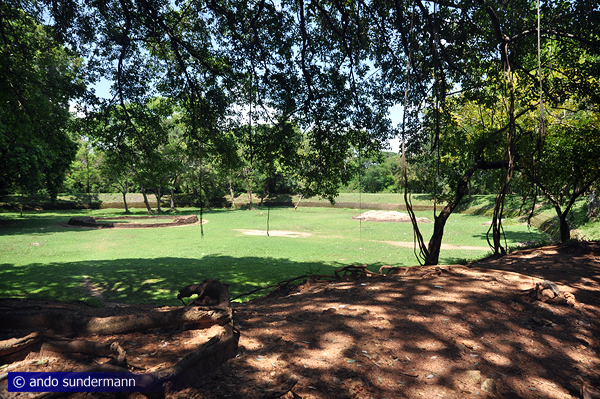
Panduwasnuwara is also called Parakramapura. The two different names refer to two different kings in very different periods of Sri Lanka's history. In popular belief, the city is atributed to the second Sinhalese king, Panduvasudewa. But the ruins that can be studied today are from the reign of King Parakramabahu, who governed the west of the island before becoming the most significant king of the Polonnaruwa period. In some respects, Panduwasnuwara is prototype of Polonnaruwa. The city from the 12th century has remnants of a moated palace and monasteries and a former tooth temple, now restored. The most mysterious edifice is a round rampart encircling a round structure in the centre, an arrangement not known from other ancient sites in Sri Lanka. The central circular structure is believed to be the place, where King Panduwasudeva's daughter was held in captivity.
